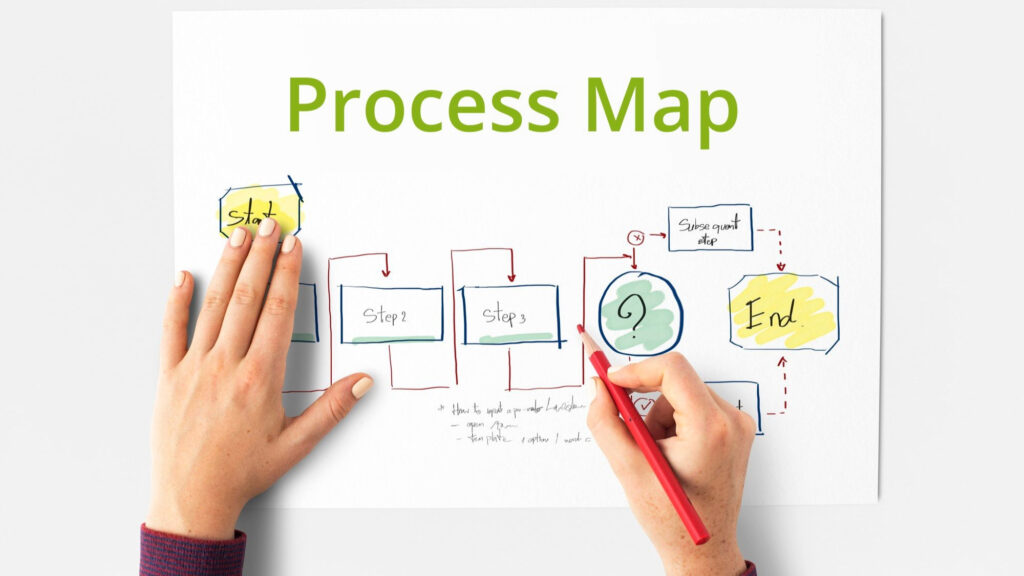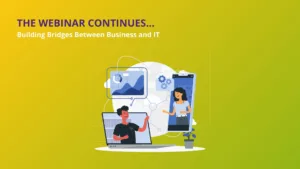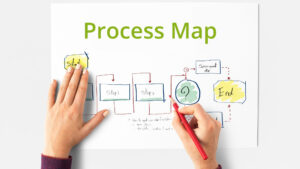What Is Process Mapping
Process mapping is the activity of visualizing all steps involved in a business process. Creating a process map allows employees across departments to identify and understand steps taken in a process. This helps ease the identification of bottlenecks and redundancies. But how do you approach the creation of a process map? Let’s walk through our process of creating a process map.
Step 1: Create an Overview
Now when starting to look into process mapping, people often focus on one specific (sub-)process. This is understandable, as often we are missing oversight in a certain process or perhaps we are even noticing some inefficiencies. However, a best practice approach involves taking a comprehensive view of the department to understand how various chain processes interconnect. Creating an overarching process overview first allows us to delve deeper into the intricacies of individual subprocesses.

To give an example of why this is important, let’s take a look at the billing process. This process is especially important to have clear understanding of, as it literally brings in the money. Several departments actively engage in the billing process, including Sales handling sales, the Service Team executing services, Logistics managing product delivery, the Finance Department processing invoices, and the Approval Committee reviewing and approving invoices, among others. Depending on the organization this process differs, but in general the billing process requires information from different channels and proper execution of the sold services or delivery of the sold goods.
If we were to only look at the billing process, we might overlook inefficiencies, redundancies or problems elsewhere in the chain. We would then be executing something called sub-optimization. When a team optimizes one small piece of a long chain process without considering any other steps in the flow, this action can negatively impact other processes or create bottlenecks elsewhere in the chain.
Step 2: Take Inventory
Once we have identified which processes are part of the chain, we start to take inventory of everything involved. We start by identifying the processes that make up the chain and then proceed to take inventory of everything involved. This step is crucial for creating a comprehensive process map, as it allows us to overview not only the people and their actions, but also to identify the data and systems in use. We then focus on understanding how people interact with these systems and how the systems integrate with each other.
In order to create a complete process map. We take inventory of the following:
- Internal stakeholders: Identify roles involved in each process, focusing on responsibilities rather than individual names. Document whether a department or a specific role is accountable.
- External officials: Consider external parties involved, such as clients in billing processes or suppliers if you’re receiving bills. It’s crucial to understand their roles, including any outsourced steps.
- Systems: Most processes involve some system, ranging from basic Excel sheets to advanced ERP systems. It’s crucial to understand all systems utilized in the process, and how they interconnect.

Last but possibly the first thing you should be doing is defining the goal of the process. It could be accuracy, timeliness, completeness, legality or something else. But when mapping a process, it is good to keep in mind why this process exists in the first place. As this helps you understand each step better.
Step 3: Building a Process Map
Once all information is gathered, including interview notes, existing process documents, and other relevant data, it’s time to convert this into a process map. This step involves creating a visual representation that accurately depicts each step of the actual process.
Now there are many ways to go about creating a flowchart. Whether you draw one on paper or create one in Microsoft Visio (our preferred tool) it is really up to your preferences. Important when building a flowchart is to keep it as simple as possible.

The flowchart needs to be simple and clear for everyone to understand. The chart should not only detail the actions taken by individuals, but also illustrate when and how different systems communicate, as well as the methods of data storage and transfer. The inclusion of the interfacing between systems means you will have one illustration that includes every single action taken, which will help you in the long run when trying to optimize or potentially digitize and automate.
To Sum Up
So, in summary to create a process map we follow a three-step approach. Now of course each of these steps requires some time and input from the people within your organization, but experience teaches us that even one session of sitting down with colleagues and discussing the steps everyone takes already offers great insight into potential redundancies or bottlenecks.
However, keep in mind that when creating your process map it is not necessary to immediately dive into fixing potential problems. It is completely thinkable that one step in the process might seem long and gruesome, but it may serve a higher purpose to the overall efficiency of the chain process. So before making any changes, make sure to understand the process and its goal as a whole.
The Benefits of Process Mapping
Mapping a process is time consuming and requires effort from a multi disciplinary team. To help you convince your team its benefits are worth reaping, let’s go over the benefits of a good process map.
Facilitating clear understanding
Let’s begin by exploring the fundamental benefits of proper process mapping, primarily its ability to enhance internal communication, which often gets overlooked in the daily hustle and bustle.
- Visual representation: A process map is quite literally a map. It transforms complex procedures into a visual format, making it easier to comprehend. Humans are visual creates; a well-designed process map can convey more effectively than pages of text.
- Standardized language: Process mapping provides standardized language. There are several languages to use, the most popular example being BPMN. This allows for anyone within the organization, regardless of their department or role.
- Detailed breakdown: By breaking down each step, stakeholders can see how individual tasks contribute to the process at large. This helps create a greater understanding of the process at a whole.
These three benefits form the core of why process mapping is essential. It’s not just about having a roadmap to reach our goals; it’s about choosing the most efficient path to our destination. Effective communication with colleagues about the chosen route ensures everyone’s involvement and understanding, even when less conventional paths are taken.
Enhancing communication across teams
When looking at chain processes, we often see cross-departmental processes. Communication across departments and different teams is not always optimal. In a situation where management and stakeholders work in one process together, a process map can be a great tool.
- Cross-departmental collaboration: Process maps facilitate the discussions across different departments. Let’s take marketing and sales for example. A process map that illustrates how the marketing department’s activities impact sales, and vice versa, will help them better coordinate their actions and collaborate more efficiently.
- Onboarding and training: For new employees, process maps serve as a training tool. It provides them with an overview of their role fits within the organizational processes. It does not eliminate their need for communication with the team but serves as a nice cheat sheet.
- Conflict resolution: When there is disagreement on how a process should be carried out, being able to look back on what you decided in the first place can help resolve conflict.
Supporting Continuous Improvement
Facilitating continuous improvement is another great benefit of process mapping. Because like we shortly mentioned before, being able to look at the visualization of your process, helps you quickly identify bottlenecks and inefficiencies.
- Feedback and suggestions: A visual map does not only help you to identify these bottlenecks, it’s also a great tool to invite feedback from team members who are directly involved in the process. Their insights are just as valuable as your own and incredibly valuable for continuous improvement.
- Identifying bottlenecks and inefficiencies: We will say it one more time, laying out a process visually helps your brain think better. Some of these bottlenecks might not be apparent when writing down a process, or during routine execution.

A process map to help decision-making
Last but not least, perhaps the greatest benefit of all, using process maps as a tool for decision making.
- Strategic planning: Process maps provide a clear picture of how current operations are run, which is essential for strategic planning and forecasting.
- Resource allocation: Understanding the flow and requirements of your process, means you can make more informed decisions about resource allocation.
- Risk management: Process maps are great in helping you identify potential risks at various stages of a process. This allows you to make use of proactive risk management strategies.
- Compliance: A process map allows you to keep track of your process and its flow, which is great when needing to comply with law and regulations.
Conclusion
The role of process mapping in achieving clarity and enhancing communication cannot be overstated. It serves as a multi-faceted tool that not only simplifies the understanding of complex processes but also fosters effective communication, collaboration, and continuous improvement across an organization. By integrating process mapping into their BPM strategy, businesses can create a more transparent, efficient, and cohesive workflow environment.



